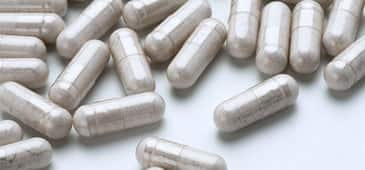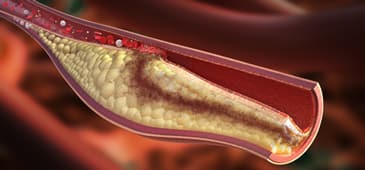
What's Hot
What's Hot
News flashes are posted here frequently to keep you up-to-date with the latest advances in health and longevity. We have an unparalleled track record of breaking stories about life extension advances.
Vitamin B6 supplementation could aid dream recall
 April 30 2018. For those who rarely remember their dreams, a randomized trial reported on April 17, 2018 in Perceptual and Motor Skills revealed that taking pyridoxine (vitamin B6) could help.
April 30 2018. For those who rarely remember their dreams, a randomized trial reported on April 17, 2018 in Perceptual and Motor Skills revealed that taking pyridoxine (vitamin B6) could help.
Acting on the findings of a pilot study reported in 2002 that found a dose-dependent effect for the vitamin in the improvement of dream vividness, color and other factors, the current double-blind trial included a larger and more diverse sample of participants to test the vitamin’s effects. One hundred Australian subjects consumed 240 milligrams pyridoxine hydrochloride, a high dose B complex supplement or a placebo before sleep for 5 consecutive days. Dreams were described daily in logbooks, along with other factors including self-rated sleep quality. "Our results show that taking vitamin B6 improved people's ability to recall dreams compared to a placebo," reported lead author Dr Denholm Aspy, of the University of Adelaide’s School of Psychology. "Vitamin B6 did not affect the vividness, bizarreness or color of their dreams, and did not affect other aspects of their sleep patterns.”
"It seems as time went on my dreams were clearer and clearer and easier to remember,” one participant reported.
"This is the first time that such a study into the effects of vitamin B6 and other B vitamins on dreams has been carried out on a large and diverse group of people," Dr Aspy announced. "The average person spends around six years of their lives dreaming. If we are able to become lucid and control our dreams, we can then use our dreaming time more productively.”
"Further research is needed to investigate whether the effects of vitamin B6 vary according to how much is obtained from the diet,” he remarked.
—D Dye
Oxidative stress may explain difference between healthy and unhealthy obesity
 April 27 2018. Research reported in an article appearing online on April 4, 2018 in the ADA journal Diabetes suggests that oxidative stress may the culprit behind unhealthy adipose (fat) tissue.
April 27 2018. Research reported in an article appearing online on April 4, 2018 in the ADA journal Diabetes suggests that oxidative stress may the culprit behind unhealthy adipose (fat) tissue.
Obesity is characterized as metabolically “healthy” or as unhealthy, i.e., associated with insulin resistance. In earlier research, Atsunori Fukuhara of Japan’s Osaka University reported that oxidative stress was increased in obese fatty tissue. In the current study, Dr Fukuhara and colleagues used a living model to demonstrate the role of fat reactive oxygen species (ROS) in the development of metabolically abnormal obesity.
The research team generated mice in which the antioxidant enzymes catalase and superoxide dismutase 1 (SOD1) were overexpressed in fat cells. They also generated other mice in which fat cell levels of the antioxidant glutathione, a precursor to the antioxidant enzyme glutathione peroxidase, were depleted.
In animals in which reactive oxygen species in fat were diminished by overexpression of antioxidant enzymes, adipose tissue expanded with less abnormal fat accumulation in the liver. In contrast, mice whose fat had more oxidative stress had less fatty tissue expansion but more fat in their livers, and decreased insulin sensitivity. Differences were also found in white adipose tissue fibrosis, new fat cell formation and function of immune cells known as macrophages. The research team identified genetic transcription alterations as a mechanism in support of the findings.
“Thus, our study uncovered the novel roles of fat reactive oxygen species in healthy adipose expansion, ectopic lipid accumulation and insulin resistance, providing the possibility for the adipocyte-targeting antioxidant therapy,” Dr Fukuhara and colleagues conclude.
—D Dye
Probiotics good for the liver, too
 April 25 2018. A presentation at the American Society for Investigative Pathology annual meeting, held during the 2018 Experimental Biology meeting April 21-25, 2018, revealed a liver-protective effect for probiotic supplementation in experimental research. Probiotics are beneficial bacteria that help support a healthy bacterial population in the gut and have been found to have benefits elsewhere in the body.
April 25 2018. A presentation at the American Society for Investigative Pathology annual meeting, held during the 2018 Experimental Biology meeting April 21-25, 2018, revealed a liver-protective effect for probiotic supplementation in experimental research. Probiotics are beneficial bacteria that help support a healthy bacterial population in the gut and have been found to have benefits elsewhere in the body.
“As the primary metabolic and detoxification hub, the liver is a critical checkpoint between the digestive functions of the gut and the rest of the body,” write Bejan Saeedi and colleagues at Emory University in their summary of the findings. “Therefore, it is likely that liver health and homeostasis may be affected through alterations in the gut microbiota.”
In the current study, the research team gave mice diets supplemented with the probiotic Lactobacillus rhamnosus GG (LGG) for two weeks followed by a high dose of acetaminophen, which can be toxic to the liver. Acetaminophen causes liver damage by increasing the formation of free radicals.
Mice that received the probiotic had less liver damage than those that received unsupplemented diets. "Administration of the probiotic LGG to mice improves the antioxidant response of the liver, protecting it from oxidative damage produced by drugs such as acetaminophen," Saeedi explained.
In a previous investigation, the team observed that Lactobacillus rhamnosus GG activated Nrf2, which regulates the expression of genes involved in neutralizing free radicals. In the current research, they found an increase in liver Nrf2 activity in mice that received the probiotic in comparison with untreated mice.
"Probiotics have been studied most intensely in the context of the gastrointestinal tract," Saeedi noted. "This study provides evidence that the effects of probiotics extend beyond the gastrointestinal tract. What makes this study unique is that it suggests a discreet molecular mechanism by which these effects are elicited."
—D Dye
Calcium supplementation may be needed in many areas of the world
 April 23 2018. A Global Map of Dietary Calcium Intake in Adults released by the International Osteoporosis Foundation on April 20, 2018 shows that people in many parts of the globe fail to consume diets that provide adequate amounts of the mineral, putting these populations at risk of osteoporosis The Map is based on findings from a study published in the December 2017 issue of Osteoporosis International.
April 23 2018. A Global Map of Dietary Calcium Intake in Adults released by the International Osteoporosis Foundation on April 20, 2018 shows that people in many parts of the globe fail to consume diets that provide adequate amounts of the mineral, putting these populations at risk of osteoporosis The Map is based on findings from a study published in the December 2017 issue of Osteoporosis International.
Although 800-1000 milligrams (mg) calcium per day is the usual recommendation for healthy adults, global intake varies significantly. The amount of calcium consumed by adult residents of Nepal averages just 175 mg per day, in contrast with 1,233 mg per day in Iceland. The majority of African, Asian and South American countries have a daily intake that ranges from to 400 mg to 700. "The Map reveals that in many parts of Asia and Southeast Asia the population has extremely low intakes of calcium in the diet, with levels often less than 400 to 500 mg a day,” observed Ambrish Mithal, who coauthored the Osteoporosis International report and is a board member of the International Osteoporosis Foundation. “In China and India, the world's most populous countries, the average intake is shown to be only 338 mg/day and 429 mg/day respectively."
"Increasing calcium intake throughout the lifespan is an important strategy to improve bone health,” noted senior author Bess Dawson-Hughes, MD, of Tufts University’s Bone Metabolism Laboratory. “For people who may not be able to get enough calcium through their diets, calcium supplementation may be needed to reach the intake requirement of 800 to 1,000 mg/day. This is particularly important for older adults who do not consume enough calcium-rich foods. In this population group, calcium supplementation combined with vitamin D, may lower the risk of broken bones."
—D Dye
Widespread testosterone deficiency associated with chronic illness
 April 20 2018. A study published on April 12, 2018 in Scientific Reports documents a high prevalence of testosterone deficiency in a sample of U.S. men, which was associated with a greater risk of multiple diseases.
April 20 2018. A study published on April 12, 2018 in Scientific Reports documents a high prevalence of testosterone deficiency in a sample of U.S. men, which was associated with a greater risk of multiple diseases.
"If we look at data for men from a population level, it has become evident over time that chronic disease is on the rise in older males," observed lead author Mark Peterson, PhD, MS, FACSM. "But we're also finding that a consequence of being obese and physically inactive is that men are seeing declines in testosterone even at younger ages."
The study included 2,161 men enrolled in the 2011-2012 National Health and Nutrition Examination Survey (NHANES). "Previous studies used clinical cohorts that were not reflective of the current male population in the United States," Dr Peterson remarked. "The cohorts they used enforced strict guidelines for patients that were accepted into the cohort. Therefore, those patients tended to be much healthier."
There was a significantly greater risk of having two or more chronic conditions (type 2 diabetes, arthritis, cardiovascular disease, stroke, pulmonary disease, high triglycerides, high cholesterol, hypertension or clinical depression) among testosterone-deficient men under the age of 40 and those aged 60 years and older compared to men in the same age groups who were not deficient. "We also found a large dose-response relationship between the age-specific low total testosterone and moderate total testosterone levels and multimorbidity, even after adjusting for obesity and muscle strength capacity," Dr Peterson added. "Which means that men should be concerned about declining total testosterone, even if it has not reached a level to warrant a clinical diagnosis."
"A lot of men may not be aware of the risk factors for testosterone deficiency because of their current lifestyle," he noted. "And more importantly, that declining levels could be contributing to a silent decline in overall health and increased risk for chronic disease."
—D Dye
Unstable atherosclerotic plaque similar to cancer
 April 18 2018. Research reported on March 19, 2018 in the European Heart Journal revealed similarities between changes in metabolism observed in unstable atherosclerotic plaque and in cancer cells. Unstable atherosclerotic plaque is vulnerable to rupture, which can cause clots that result in heart attack or stroke. There are currently no precise methods to identify and effectively treat high-risk plaque.
April 18 2018. Research reported on March 19, 2018 in the European Heart Journal revealed similarities between changes in metabolism observed in unstable atherosclerotic plaque and in cancer cells. Unstable atherosclerotic plaque is vulnerable to rupture, which can cause clots that result in heart attack or stroke. There are currently no precise methods to identify and effectively treat high-risk plaque.
"The altered metabolism we have identified in high-risk plaque is also present in cancer cells,” explained lead researcher Harry Björkbacka, who is an associate professor of experimental cardiovascular research at Lund University. “Just as the metabolism in cancer cells is reprogrammed to be able to digest sugar quickly, the sugar uptake of the dangerous plaque seems to be greater than that of stable plaque."
Dr Björkbacka’s team measured 165 metabolites in 159 carotid arterial plaques obtained from patients who underwent surgical plaque removal. They identified different metabolite profiles in high-risk and stable plaques which suggested altered metabolism in those that were high-risk. The metabolic signature of the high-risk plaques was consistent with that observed in cancer cells and activated white blood cells that cause inflammation, which is characterized by increased amino acid utilization and break down of sugar, and lowered fatty acid oxidation. The finding suggests that treatment with agents that counteract this altered metabolism could help protect against inflammation in plaque which is associated with cardiovascular disease.
"The discovery that high-risk plaque, unlike stable plaque, has a reprogrammed metabolism, opens up new opportunities for identifying the dangerous plaque, for instance by visualizing the uptake of nutrients specific to the reprogrammed metabolism using a PET camera", Dr Björkbacka stated.
“Targeting the metabolism of atherosclerotic plaques with novel metabolic radiotracers or inhibitors might therefore be valid future approaches to identify and treat the high-risk atherosclerotic plaque,” the authors conclude.
—D Dye
Rather than contributing to arrhythmia, coffee may help prevent it
 April 16 2018. Contrary to common belief, coffee does not increase abnormal heart rhythms known as arrhythmias but, rather, helps prevent them, according to a review published in the April 2018 issue of the Journal of the American College of Cardiology: Clinical Electrophysiology.
April 16 2018. Contrary to common belief, coffee does not increase abnormal heart rhythms known as arrhythmias but, rather, helps prevent them, according to a review published in the April 2018 issue of the Journal of the American College of Cardiology: Clinical Electrophysiology.
"There is a public perception, often based on anecdotal experience, that caffeine is a common acute trigger for heart rhythm problems," stated lead author Peter Kistler, MBBS, PhD, of Alfred Hospital and Baker Heart and Diabetes Institute in Australia. "Our extensive review of the medical literature suggests this is not the case."
One cup of coffee contains an average of 95 milligrams of caffeine. Caffeine blocks the effects of adenosine, a compound that can facilitate the type of arrhythmia known as atrial fibrillation. Population-based studies have documented an association between a reduction in atrial fibrillation and greater caffeine ingestion. In fact, a meta-analysis that included 228,465 subjects found an inverse relationship between drinking coffee and atrial fibrillation occurrence. While regular coffee drinkers had a 6% average reduction in atrial fibrillation, pooled results from studies with adjustment of potential confounders found a decrease of 11% for low doses and 16% for high doses of caffeine.
Dr Kistler and colleagues determined that caffeine also has no effect on ventricular arrhythmias. Doses of up to 500 milligrams per day have not been associated with ventricular arrhythmia rate or severity. Only at 9-10 cups per day has coffee been associated with an increase in risk.
"Caffeinated beverages such as coffee and tea may have long term antiarrhythmic properties mediated by antioxidant effects and antagonism of adenosine," Dr Kistler noted. "In numerous population-based studies, patients who regularly consume coffee and tea at moderate levels have a lower lifetime risk of developing heart rhythm problems and possibly improved survival."
—D Dye
Higher vitamin intake associated with lower risk of pancreatic cancer
 April 13 2018. A meta-analysis published in March, 2018 in the journal Medicine found evidence for an association between higher vitamin intake and a lower risk of cancer of the pancreas. The protective association was particularly strong for vitamins B12 and D.
April 13 2018. A meta-analysis published in March, 2018 in the journal Medicine found evidence for an association between higher vitamin intake and a lower risk of cancer of the pancreas. The protective association was particularly strong for vitamins B12 and D.
Ying Liu and colleagues selected 25 studies that included a total of 1,214,995 men and women for their analysis. Studies included case-control investigations, randomized controlled trials, cohort studies, prospective studies and retrospective studies that provided data on the intake of vitamins A, B vitamins, C, D or E. Pancreatic cancer cases totaled 8,740.
Subjects among the highest vitamin intake group in the prospective studies had a 10% lower adjusted risk of developing pancreatic cancer compared to those among the lowest intake group. In retrospective studies, the adjusted risk was 21% lower for those whose vitamin intake was highest. After further analysis, vitamin B12 and vitamin D emerged as significantly protective against the disease. In a dose-response meta-analysis, intake of 10 micrograms or more vitamin B12 lowered the incidence of pancreatic cancer by 27% and for vitamin D, the associated risk was lowered by 25%.
In their discussion, the authors list a number of mechanisms to explain the effects of vitamins in pancreatic cancer cells. As examples, vitamin E has been shown to induce cell cycle arrest and apoptosis (programmed cell death) in human pancreatic cancer cells and vitamin B1 has been shown to increase caspase-3 activity (involved in apoptosis) and decrease pancreatic cell proliferation. “Nevertheless, the mechanisms of vitamins reducing the risk of pancreatic cancer need further Investigation,” Dr Liu and associates conclude.
—D Dye
Higher selenium levels equal improved survival in decade-long study of older individuals
 April 11 2018. An article that appeared in the May 2018 issue of the Journal of Nutrition, Health & Aging revealed a lower risk of mortality over a ten year period among older men and women who had higher serum levels of the mineral selenium.
April 11 2018. An article that appeared in the May 2018 issue of the Journal of Nutrition, Health & Aging revealed a lower risk of mortality over a ten year period among older men and women who had higher serum levels of the mineral selenium.
“It is well known that oxidative stress increases with age and that aging is characterized by selenium deficit due to low intake, reduced physical functioning or severe pathologies,” comment Silvia Giovannini and colleagues in their introduction to the article.
The investigation included 347 participants in the Aging and Longevity in the Sirente geographic area, (ilSIRENTE) study, a prospective cohort study that involved men and women aged 80 years and older who resided in a mountain community in Italy. Blood samples collected at enrollment were analyzed for factors that included serum selenium, which was categorized as low or high. Subjects were followed for ten years, during which 248 deaths occurred.
Having a low level of selenium was associated with a 29% greater adjusted risk of death from all causes over the ten year follow-up period compared with higher levels. Greater selenium levels were associated lower levels of interleukin-6 and C-reactive protein, which are markers of inflammation. According to the authors “Selenium deficiency is associated with many inflammatory tissue reactions and with disease progression, including myocarditis, human immunodeficiency virus, thyroid dysfunction, arthritis, cancer, depression, and cardiovascular disease. This selenium deficiency-related hastening of a host of disease processes may partly clarify the association between mortality and lower selenium levels.”
“Our findings support the hypothesis of a strong implication of selenium status in the process of living an extremely long life,” they conclude.
—D Dye
Meta-analysis finds probiotic use associated with better lipids and blood pressure
 April 9 2018. In December 2017, the journal Medicine (Baltimore) published the results of a meta-analysis of 10 randomized, controlled trials that found reductions in lipids, blood pressure and blood glucose among diabetic men and women who received probiotics in comparison with those who did not receive them.
April 9 2018. In December 2017, the journal Medicine (Baltimore) published the results of a meta-analysis of 10 randomized, controlled trials that found reductions in lipids, blood pressure and blood glucose among diabetic men and women who received probiotics in comparison with those who did not receive them.
“It has been demonstrated that probiotics can ameliorate the state of insulin resistance and regulate lipid metabolism in in vitro studies or animal models,” write Jun He of the Third People’s Hospital of Changzou, China and colleagues in their introduction. They add that studies have shown that probiotics can change the intestinal micro-ecosystem and play a positive role in type 2 diabetes mellitus treatment.
For their analysis, the researchers selected 10 trials that included 297 participants who received probiotics and 294 participants who served as controls. Subjects in the probiotic groups received probiotic supplements, yogurt, shakes, or other foods, and control groups received a placebo, various nonprobiotic foods or dietary advice during the course of the trials, which lasted from 4 to 12 weeks.
Compared to the controls, probiotic treatment was associated with a significant decrease in total cholesterol, low-density lipoprotein (LDL) cholesterol, systolic blood pressure, diastolic blood pressure and fasting blood glucose, as well as an increase in high-density lipoprotein (HDL) cholesterol.
“This meta-analysis suggests that probiotics have beneficial effect on lipid profiles and blood pressure,” the authors conclude. “However, there is still a need of conducting a multicenter, larger-scale, and long-time randomized controlled trial to confirm the accurate effect of probiotics on type 2 diabetes mellitus.”
—D Dye
Adding CoQ10 to Mediterranean diet improves post-meal metabolic state
 April 6 2018. The March 2018 issue of the Journals of Gerontology: Biological Sciences Series A reports a trial conducted in Spain that found that a Mediterranean diet lowered levels of advanced glycation end products (AGEs) and oxidative stress in older men and women, and that coenzyme (CoQ10) accentuated this effect. Advanced glycation end-products are proteins and lipids that have become bonded to sugar molecules, with damaging effects.
April 6 2018. The March 2018 issue of the Journals of Gerontology: Biological Sciences Series A reports a trial conducted in Spain that found that a Mediterranean diet lowered levels of advanced glycation end products (AGEs) and oxidative stress in older men and women, and that coenzyme (CoQ10) accentuated this effect. Advanced glycation end-products are proteins and lipids that have become bonded to sugar molecules, with damaging effects.
The crossover study included 10 men and 10 women aged 65 years and older who were assigned to four weeks each of a Mediterranean diet, a Mediterranean diet plus 200 milligrams per day CoQ10, or a Western diet rich in saturated fat that provided the same number of calories. Amount of AGEs consumed, serum AGEs, AGE receptors and other factors were assessed at the beginning of the study and at end of each dietary intervention period.
Higher dietary AGEs and serum markers of AGE accumulation were detected following the high fat Western diet in comparison with both Mediterranean diets. These markers, when measured after a meal, were lowest following consumption of the Mediterranean diet plus CoQ10 in comparison with the other diets. Consumption of a Mediterranean diet was also associated with higher levels of a gene that helps remove AGEs and an increase in estrogen receptor alpha messenger RNA, indicating protection against estrogen receptor reduction caused by AGEs.
“The addition of the CoQ to a Med-style diet provides an additional beneficial effect of reducing the oxidative and inflammatory state, particularly in the postprandial phase,” the authors report.
“Because elevated oxidative stress/inflammation and AGEs are associated with clinical disease in aging, the enhanced protection of a Mediterranean diet supplemented with CoQ10 should be assessed in a larger clinical trial in which clinical conditions in aging are measured,” they recommend.
—D Dye
Greater cruciferous vegetable intake associated with reduction in carotid artery wall thickness
 April 4 2018. The April 17, 2018 issue of the Journal of the American Heart Association contains an article thatsuggests a protective effect for cruciferous vegetables against increased carotid artery wall thickness, a measure of atherosclerosis. Cruciferous vegetables, which include broccoli and kale, have been associated with many health benefits, including protection against some cancers.
April 4 2018. The April 17, 2018 issue of the Journal of the American Heart Association contains an article thatsuggests a protective effect for cruciferous vegetables against increased carotid artery wall thickness, a measure of atherosclerosis. Cruciferous vegetables, which include broccoli and kale, have been associated with many health benefits, including protection against some cancers.
"This is one of only a few studies that have explored the potential impact of different types of vegetables on measures of subclinical atherosclerosis, the underlying cause of cardiovascular disease," announced lead author Lauren C. Blekkenhorst, who is a PhD candidate at the University of Western Australia.
The study included 954 women aged 70 years and older. Dietary questionnaires ascertained type and frequency of vegetable consumption. Sonograms measured carotid artery wall thickness and carotid plaque severity.
Among subjects whose total intake of vegetables was classified as high, carotid artery wall thickness averaged 0.05 millimeters less than subjects whose intake was low. "That is likely significant, because a 0.1 millimeter decrease in carotid wall thickness is associated with a 10 percent to 18 percent decrease in risk of stroke and heart attack," Dr. Blekkenhorst commented.
For each 10 gram per day increase in cruciferous vegetable intake, average carotid wall thickness was 0.8% lower. "After adjusting for lifestyle, cardiovascular disease risk factors (including medication use) as well as other vegetable types and dietary factors, our results continued to show a protective association between cruciferous vegetables and carotid artery wall thickness," Dr. Blekkenhorst concluded.
Since the study was observational, a cause and effect relationship between greater cruciferous vegetable intake and decreased carotid artery wall thickness needs to be investigated. "Still, dietary guidelines should highlight the importance of increasing consumption of cruciferous vegetables for protection from vascular disease," Dr. Blekkenhorst asserted.
—D Dye
Evidence accumulates in favor of Mediterranean diet for healthy aging
 April 2 2018. The March 2018 issue of The Journals of Gerontology, Series A: Biological Sciences and Medical Sciences published a series of articles that reveal new associations between a Mediterranean diet and healthy aging outcomes. The diet is characterized by a high intake of whole grains, legumes, fresh vegetables, fruit, extra-virgin olive oil, nuts, and seeds, moderate consumption of fish, and the inclusion of small amounts of dairy products and wine.
April 2 2018. The March 2018 issue of The Journals of Gerontology, Series A: Biological Sciences and Medical Sciences published a series of articles that reveal new associations between a Mediterranean diet and healthy aging outcomes. The diet is characterized by a high intake of whole grains, legumes, fresh vegetables, fruit, extra-virgin olive oil, nuts, and seeds, moderate consumption of fish, and the inclusion of small amounts of dairy products and wine.
In a review by Luigi Fontana, MD, PhD, and his colleagues, five potential health-modifying adaptations induced by the Mediterranean diet were discussed, including lipid reduction, protection against inflammation, oxidative stress and platelet aggregation; modification of cancer-promoting growth factors and hormones, amino acid restriction-induced inhibition of nutrient-sensing pathways and gut microbiota-mediated production of metabolites that influence metabolic health. A number of these pathways are believed to be mechanisms of aging biology.
Other articles documented the benefit of the diet on physical function, the positive effects of adding a coenzyme Q10 supplement to the diet; effects of the interaction between genetic variants and the diet on inflammation and aging, and the favorable role of adherence to the Mediterranean diet at midlife on health maintenance during aging. However, editorialists Michelle A. Mendez, PhD, and Journals of Gerontology: Medical Sciences Editor-in-Chief Anne B. Newman, MD, FGSA, stress that measurement of adherence to the diet can vary due to the use of different diet scoring systems.
“Findings from these studies point to potential mechanisms involving the chronic inflammation increasingly thought to be a hallmark of accelerated aging,” they write. “Greater clarity on how this diet is defined, in both interventions and observational studies, will be critical in the aim of achieving a consensus on how to optimally apply this dietary pattern towards maximizing healthy aging."
—D Dye

